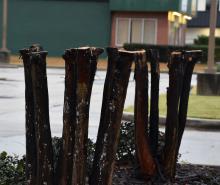Information Possibly Outdated
The information presented on this page was originally released on February 1, 2016. It may not be outdated, but please search our site for more current information. If you plan to quote or reference this information in a publication, please check with the Extension specialist or author before proceeding.
Prune crape myrtles, but don’t butcher them
Every gardener I know is asking the same question: When’s spring going to get here?
No doubt we are getting close as we wait breathlessly this week for the prognostication of Punxsutawney Phil seeing his shadow and whether or not we can look forward to six more weeks of winter weather.
This time of year, there’s also a lot of controversy going around gardening circles regarding our beloved Southern gem, the crape myrtle. And to set your mind at ease, it’s not whether the spelling is crape or crepe. I prefer crape, but either one is acceptable in polite company.
The controversy I’m referring to is the pruning -- or shall I call it the annual butchering -- of crape myrtles. This happens almost like clockwork. I was speaking with a nursery friend of mine this weekend, and he referred to Feb. 1 as the beginning of Crape Murder Season.
We see crape murder all around us where someone has hard pruned a crape myrtle back to the trunk or a major branch. This is not a new occurrence, but it is increasingly common among the commercial landscape maintenance companies who want to get in and then move on to the next job. Sometimes the cuts are so precise and uniform it seems they were using laser levels. Homeowners see this and assume if the professionals are doing it, then it must be correct.
The trouble is crape myrtles are extremely resilient, and, since they bloom on the current season’s growth, the bad pruning practices are glossed over, not to mention the gross, enlarged knots on the branches.
Contrary to popular belief, while hard pruning produces what appears to be lusher foliage, this growth actually results in a decrease in overall flowering. Heavy pruning can’t be used as a method to control shape -- in fact, it destroys the tree’s natural form. There are a variety of natural shapes available, depending on the variety selected.
Finally, you don’t need to prune a crape myrtle to control its size. If they are correctly sized for the planting location, crape myrtles do not need to be pruned every year.
Every crape myrtle will need minimal, selective pruning for the removal of seed heads to tidy the tree up. Look for occasional misshapen branches or damaged branches and remove them.
One of the problems with the extreme pruning of crape myrtles has to do with planting a large-growing tree in a space more fitted for a small-growing tree. It’s the wrong plant in the wrong place.
When selecting a crape myrtle, consider the mature size you want and choose a selection to meet that criteria. If you want a white-flowering crape myrtle (there are similar sizes available for all of the crape myrtle colors), here is a list of mature heights:
- Pixie White, 3 feet
- Delta Moonlight, 10 feet
- Acoma, 14 feet
- Byer’s White, 20 feet
- Natchez, 30 feet
Here are some quick tips for properly pruning crape myrtles:
- Decide if the tree actually needs to be pruned. If pruning is necessary, never do it before February.
- Remove seed heads to maintain a more tidy late-winter, early-spring appearance.
- Remove branches that are crossed, damaged or misshapen, as well as those that may be touching a house or other structure.
For more information on proper care, including pruning and feeding of crape myrtles for our Mississippi landscape, read the Mississippi State University Extension Service Publication 2007, “Crape Myrtle: Flower of the South.”










